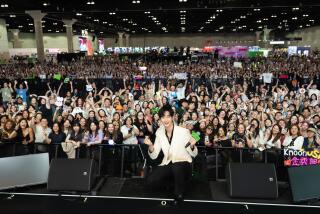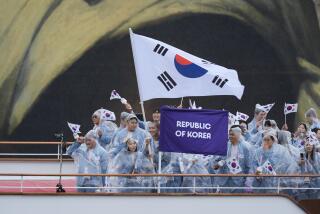Let the games bedazzle
Pyongyang, North Korea — WHEN it comes to paying tribute to the ruling Kim family in North Korea, size matters.
Check out the towering bronze memorial to founding father Kim Il Sung on Mansu Hill overlooking the capital, Pyongyang -- a skyscraper of a statue. Or the Arch of Triumph built to commemorate Kim’s return from exile. A replica of the Arc de Triomphe in Paris, the North Korean version rises, crucially, 39 feet higher than the original.
Yet the most gargantuan, super-sized ode of all may be the nearly 90-minute musical tribute to Kim called “Arirang,” a surreal piece of performance art whose reputedly 100,000-strong cast wrapped up a two-month run in Pyongyang last week. Named after a mournful Korean folk song about lost love, “Arirang” recounts the indefatigable Great Leader Kim’s struggle against North Korea’s existential enemies -- the imperialist Japanese followed by imperialist Americans -- and then praises the socialist “paradise” that Kim built once he’d seen them off.
The massive floor show blankets the field of Pyongyang’s May Day Stadium (capacity 150,000) with columns of dancers and singers, gymnasts and acrobats, soldiers and schoolchildren. It is part of a uniquely North Korean art form known as mass games, and it is seen by the ruling leadership under Kim’s son and successor, Kim Jong Il, as an effective way to keep the message of collective struggle -- and struggle it is in this hungry police state of 23 million -- in the public eye.
It is also arguably the most ambitious extravaganza ever to flicker across a choreographer’s imagination. By comparison, a stadium rock show in the West looks about as sophisticated as a raised Bic lighter. For “Arirang,” think stadium opera lighted by lasers, with tumbling gymnasts and rivers of performers in colorful costumes, soldiers brandishing bayonets and acrobats dropping from the top of the stadium on bungee cords.
Perhaps the most stunning element is the atmospheric backdrop provided by between 15,000 and 20,000 schoolchildren positioned in the seats along one grandstand, facing the audience. They all hold chest-sized booklets of colored cards, which they flip to different pages on cue to create different mosaics. The kids are in effect the lightbulbs in a human Jumbotron, and they produce shimmering landscapes of mountains and rivers, raging battlefields, and Korean faces that express emotions from ferocity to joy.
The precision is as much a testament to human muscle memory as it is homage to the slogan-happy Kims. And it has a distinctly disturbing side. Critics say “Arirang’s” wow factor in choreography is achieved on the back of ruthless training -- several months of 10-hour-a-day practice drills that turn children as young as 4 or 5 into performing robots.
“They conduct it every year as a method to reinforce and remind people of the ideology,” says Kwak Tae Jung, a human rights activist based in Seoul who has interviewed 10 North Korean defectors who participated in previous mass games. The first “Arirang” was staged three years ago, but mass games with similar themes celebrating the cult of the Kim family have been a staple of North Korean propaganda for more than 40 years.
The defectors describe practicing for hours without food or bathroom breaks. They recall being assigned to classes called “platoons” and say the children of Pyongyang’s elite families were exempt from being conscripted into singing and dancing for the regime.
“People are not paid,” says Kwak, though “once every four or five years, the government would give TV sets or wristwatches as gifts to those who participated.”
“They’ve been doing it for decades,” he says. “They consider it natural.”
That’s the idea, of course. North Korean reviews of the 2005 show (Guess what? They liked it) proclaimed it of “high ideological and artistic value.” As good Communists, the performers are expected to surrender to the collective. “The Unity of a Single Heart,” reads one of the show’s slogans in the backdrop, in case the participants needed reminding.
And that’s why the North Koreans believe the best tickets for “Arirang” are in the upper levels. The higher you sit, the more you see the patterns, not the people. Up high, the deluxe tickets go for 300 euros ($362) a pop; lower seats drop to half that for first class and down to 100 euros ($120) in second class, where the view is closer to the field.
Those are prices for foreigners, of course. North Koreans get freebies to attend as part of their patriotic duty. State media reported in September that 3 million people would attend, many traveling from the countryside into the normally closed capital on special trains.
Only foreigners buy tickets. And this year, there were probably more Westerners in Pyongyang than ever before.
A softened tone
THE 2005 “Arirang” coincided with celebrations marking 60 years of Kim family dynastic rule, and the regime chose the occasion to temporarily shuck off its pathological paranoia toward foreigners and bring a little hard currency into the country. About 7,000 South Koreans piled into Pyongyang, along with a smaller number of Western tourists and even a rare smattering of Americans -- though North Korean visas for Americans remained about as hard to come by as courtside seats at Staples Center when Shaq comes to town.
Still, there were three planeloads a day from Seoul landing during “Arirang,” the visitors carefully shuttled from hotels to tourist sites in isolation so they wouldn’t have contact with local Koreans. The bigger South Korean presence may explain why this year’s “Arirang” adopted a slightly less belligerent tone than in the past. (“Our expressions of American imperialism are only in a historical context now,” says Choe Jong Hun, an official with the government’s cultural exchange department.) Instead, the show concluded with a misty-eyed plea for unification of the Korean peninsula.
The softer tone may have been a sop to South Koreans who paid more than $1,000 for the short flight from Seoul, a ticket to “Arirang” and a hotel. But the visitors reacted to the unification theme with wild waving of white unified Korea flags from their segregated section in the stadium. “It was pretty clear the audience for this show was the South Koreans,” says Don Parrish, a well-traveled American who was among a few who got visas and watched from the 150-euro seats. “They appealed to that emotional tug of ‘We’re all Korean.’ ”
All the same, there was plenty of militarist bluster in the program too.
“Arirang” presents North Korea as a victim of the 20th century’s imperial storms: occupied by Japan, then freed by a glorious uprising only to fall back into civil war with the South and its American allies.
The four-act, 13-scene story opens with the bank of schoolchildren providing images of the pristine Korean landscape, mountain peaks and deep rivers. Violation is around the corner. The Japanese invade first, their early 20th century subjugation of the Korean peninsula coming when Kim Il Sung was just a boy. Fire licks the land. Korean men are led away and atrocities committed. Women weep.
Enter the adult Kim Il Sung, a guerrilla leader now, arriving in an explosion and ball of fire. The crowd cheers politely, a touch dutifully perhaps. The backdrop becomes Socialist Realist war art: soldiers hauling machine guns across battlefields, commanders leading charges as explosions pop near them.
The cult of Kim has its own take on how the Japanese were driven from the Korean peninsula. The rest of the world may subscribe more or less to the version that Japanese Emperor Hirohito capitulated in August 1945, with the Americans poised to invade Japan and with his cities, notably Hiroshima and Nagasaki, in ashes. The official North Korean narrative describes the liberation of Korea as an almost single-handed undertaking by Kim. (Most non-North Korean historians place Kim as a captain in the Russian army living outside Korea at war’s end.)
In “Arirang,” the Japanese are driven off in a Korean military spectacle that includes female soldiers in short skirts wielding swords and male soldiers carrying bayonets that glint in the lights.
“Our Great Leader waged an energetic struggle against the Japanese,” says guide Ryu Ok Hui at Pyongyang’s Museum of the Victorious Fatherland Liberation War, where the potted North Korean version of World War II is preserved. Americans, she allows when pressed, “might have made a small contribution” to defeating the Japanese and ending their colonial rule. But not much.
No matter. The Americans quickly don the black hat for the 1950s Korean War, before the People’s Army again drives the imperialists back south of the current demarcation line.
“Arirang’s” choreographers turn the postwar show over to the kids. Times were tough, the third act -- called “Tremendous Change” -- acknowledges. But life slowly improved over the years, thanks to the endless hours of work and worry put in by the Great Leader. On the field, young children in costume pretend to splash in water, while the animated backdrop shows healthy, almost chubby, kids with wide smiles.
The cards in the grandstand spell out “Let’s Turn Grass Into Meat.” Moments later, they have flipped again into a cartoon panel of goats and cows, ostriches, roosters and pigs, happily playing instruments and dancing a jig in a barnyard band.
It is a jarring clash with the reality of North Korea, where international aid agencies feed more than 6 million people a year and where fully mechanized agriculture is still a dream down the road. The North claims to be having a bumper harvest this year, but a trip through the countryside shows people bringing the grain in by hand, on their backs or tugging wooden ox carts.
Nor does “Arirang” have a dance routine for the famine that killed hundreds of thousands in the 1990s.
Still, the show goes on. “My Prosperous Country” gives way to “Higher and Faster” and “Single-Mindedness,” scenes that show North Korea entering the age of satellite launches and high technology -- even though the regime still blocks access to the Internet.
Differing reactions
FITTINGLY, “Arirang” concludes with a dream. Act 4 is “The Arirang of Reunification,” in which North-South divisions are overcome, mothers are reunited with sons, and the Korean peninsula appears whole again on the globe.
The South Koreans in the crowd go bananas. Some are on their feet, waving flags, cheering. The North Koreans are subdued, almost dulled. Some stare at the excitement in the South Korean section. They have been given no flags to wave.
“North Korea is still the same,” Oh Young Hee, a 35-year-old gymnast who fled the North two years ago, told human rights activist Kwak. “People move like machines. There is no other country that can compare with North Korea in making its people move like machines.”
From his seat in May Day Stadium, American tourist Parrish says he watched with awe as the human billboard flashed its scenes. “I’ve never seen anything like it on that scale,” the 61-year-old Parrish says.
But his eyes picked up something else as he studied the bank of schoolkids flipping their booklets of cards: mistakes.
“I’m a computer guy, and it was like looking at human pixels,” he says later. “It was virtually perfect. But if you see one red card sticking out in a sea of black, well, you know that’s a mistake.
“I saw four or five errors,” he says positively.
Hope, then, that the programming is not perfect.
Bruce Wallace is The Times’ Tokyo Bureau chief. Seoul Bureau Chief Barbara Demick contributed to this report.
More to Read
The biggest entertainment stories
Get our big stories about Hollywood, film, television, music, arts, culture and more right in your inbox as soon as they publish.
You may occasionally receive promotional content from the Los Angeles Times.










